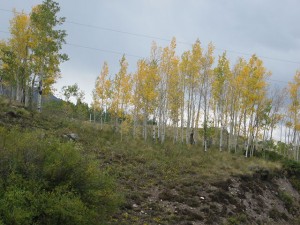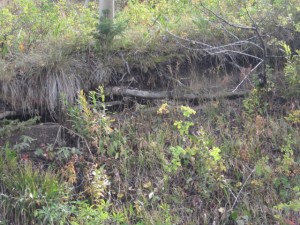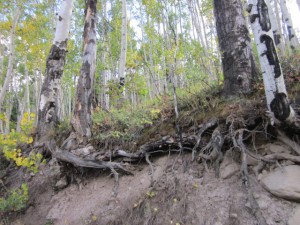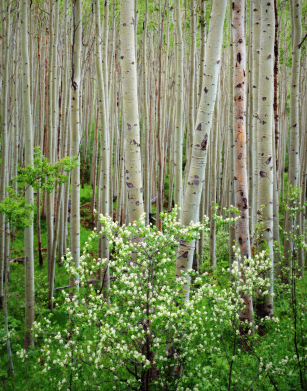“Maybe you are searching among branches for what only appears in the roots.”
– Rumi
 I’ve always been so drawn to them—Aspen trees. Their beauty bedazzles. You have to stop and stare. On our recent travels to the rocky majesty of Crested Butte, Colorado, my husband Pete and I did just that, forced to look closer and take photos of what we long ago discovered about them: These gorgeous groves are connected by one single seedling spread by root suckers! Brand new stems in the colony appear at up to 98-130 feet from the parent tree.
I’ve always been so drawn to them—Aspen trees. Their beauty bedazzles. You have to stop and stare. On our recent travels to the rocky majesty of Crested Butte, Colorado, my husband Pete and I did just that, forced to look closer and take photos of what we long ago discovered about them: These gorgeous groves are connected by one single seedling spread by root suckers! Brand new stems in the colony appear at up to 98-130 feet from the parent tree.
Pointing the camera at their legendary roots I saw for myself the wonder of their reputation. Entwined together, as if holding hands, were rows-upon-rows of gnarly root systems—one disappearing into the grasp of the other beside it. You could barely tell which root belonged to which tree. It all seemed like one continuous extension reaching out to the next.
 If left untouched, each individual tree can actually live for 40 to 150 years above ground, but it is this astounding root system of the colony that is so long-lived. There are cases in which such root systems thrive for thousands of years, sending up new trunks as the older trunks wither and die off above ground.
If left untouched, each individual tree can actually live for 40 to 150 years above ground, but it is this astounding root system of the colony that is so long-lived. There are cases in which such root systems thrive for thousands of years, sending up new trunks as the older trunks wither and die off above ground.
One famous colony grows in Utah and has been given the name of “Pando” (Latin for “I spread”). The colony is also known as “The Trembling Giant” and is estimated to be 80,000 years old, making it possibly the oldest living colony of Aspens. Some Aspen colonies become tremendously large with time, spreading over 3 feet per year, eventually covering acres of land. They’re able to survive forest fires because their roots are below the heat of the fire with new sprouts growing after the fire burns out. How amazing is that?!
 This tree is a survivor because of its resilience and strength—its very roots stand together in support of life’s most daunting challenges. As a grove the Aspen can and does withstand much in life that it wouldn’t be able to handle as a singular entity. I know this is the reason why I love the Aspen so much. It symbolizes what I wish we of the human species would realize. We are one and the same. Yes, we each have our own patterns, styles, colors, languages, cultures, religions, etc., etc., etc. but we are each more the same than not. Our uniqueness—our “branches” and “leaves” may set us apart, but it is our similarities that connect us. We are born of the same “root system” thriving from the same foundation of life that feeds and nurtures us all. We are one. Unfortunately, I believe we have so focused on our differences that we have lost sight of our common ground.
This tree is a survivor because of its resilience and strength—its very roots stand together in support of life’s most daunting challenges. As a grove the Aspen can and does withstand much in life that it wouldn’t be able to handle as a singular entity. I know this is the reason why I love the Aspen so much. It symbolizes what I wish we of the human species would realize. We are one and the same. Yes, we each have our own patterns, styles, colors, languages, cultures, religions, etc., etc., etc. but we are each more the same than not. Our uniqueness—our “branches” and “leaves” may set us apart, but it is our similarities that connect us. We are born of the same “root system” thriving from the same foundation of life that feeds and nurtures us all. We are one. Unfortunately, I believe we have so focused on our differences that we have lost sight of our common ground.
In my research about the Aspen I came upon this beautiful article by Jon Mertzon (May 28, 2010, Everyday Life), that reinforces this perspective of strength in numbers. I hope you enjoy Jon’s astute and sensitive commentary on how the Aspen is proof of what living together in harmony looks like…
Aspen Trees Set a Community Example
by Jon Mertz – May 28, 2010, The Thin Difference
 Aspens are wonderful trees. They offer qualities which instruct us to look beyond beauty. Aspens illustrate an effective community.
Aspens are wonderful trees. They offer qualities which instruct us to look beyond beauty. Aspens illustrate an effective community.
Rarely is their just one Aspen tree. By their nature, Aspens are not a solitary tree. Their roots spread below the earth’s surface and spring to life others to form a group. Aspens grow as a community; they are interconnected by their roots and share nutrients and resources to support each other.
Underneath, they are survivors. An Aspen’s roots can remain dormant for years. At the right time, they jump to life and re-generate as a community. Aspens have strength and durability, unseen by many.
Beyond their support for each other, they serve others. Animals gain nourishment in the winter months from an Aspen’s trunk while pains can be soothed through their medicinal, aspirin-like value. Even people can gain protection from the sun or relieve a burn by rubbing an Aspen’s bark on their skin. Aspen trees provide a calming beauty while healing cuts and pains and restoring others outside their bonded community.
Too many times, we live in our communities as an individual or as a self-contained family. Connections through Facebook and LinkedIn easily multiple, but the deep-rooted links within a face-to-face community are often absent. Our communities tend to be more solitary or thin surfaced.
How much do we know about the neighbor a few doors down? How do we support each other within our neighborhood block?
It is always amazing to me how superficial we are with our community relationships and, by superficial, I mean the relationship is more “acknowledged” based versus knowing something a little deeper about them – their occupation, their family members, their joys, their concerns… This is not meant to be a Mrs. Kravitz-type relationship, but an Aspen-based – supportive and connected – type relationship.
Another import element to our community needs to be outreach, helping others who may have hit hard by the current economic waves or weather-driven disasters or just need an attentive ear to listen and comfort. Offering a helping hand to other communities is critical in thinking outside our immediate walls and engaging in a larger network of people.
The beauty in this type of human community will outshine what a grove of Aspens can ever produce. Deeper, supportive relationships within our neighborhoods will enable us to lead richer lives and extend our reach more easily to others a mile down the road or in the next state or country. The common thread will be a well-grounded root system which connects and supports us. In other words, the strength of our immediate community will allow us to stretch our helping hand further out.
The decisions we make in how we connect with our community will drive how our society continues to develop. Will we be more insular or more outreaching? Will we be more self-centered or people-centered? Will we be a better society?
The next time you see a neighbor, stop, talk, and listen. Go beyond the surface questions. Ask them what is going on in their job, their family, their life. Make a connection. Develop the roots.
Just as an Aspen community of trees can regenerate themselves after being dormant for many years, the roots of our community need to rejuvenate and connect again.
If you like this article or have a comment, let Cara know. She loves feedback!
